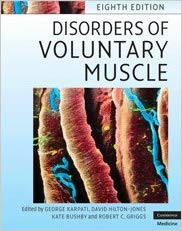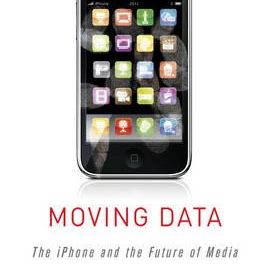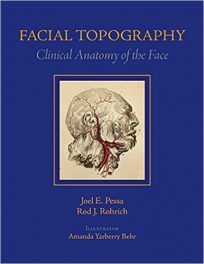 Editors: George Karpati, David Hilton-Jones, Kate Bushby, and Robert C. Griggs
Editors: George Karpati, David Hilton-Jones, Kate Bushby, and Robert C. Griggs
Publisher: Cambridge University Press – 520 pages
Book Review by: Nano Khilnani
Knowledge in the field of myology that studies disorders of muscles, has grown rapidly in the last few decades, the editors point out in their Preface. This is mainly due to, and as a consequence of, the application of molecular science. Using the molecular science approach in research on muscular disorders has led to:
- Discoveries of new entities
- A better understanding of the pathogenesis of the relevant diseases
- Improved diagnostic approaches
- Surge if advanced treatments
The current (eighth) edition of this unique book appeared in 2010, and has many updates to the seventh edition published in 2009, including the bullet points shown above. .The first edition appeared more than half a century ago in 1964, and that there have been so many editions spanning 54 years so far, is a true testament to the medical usefulness and commercial success of this book that has become a leading one on the disorders and diseases of muscles.
Its four editors named above have done a marvelous job commandeering so many experts in this field. Their contributions to this book are invaluable, particularly because knowledge and practice in the field of mycology is expanding so rapidly that it is difficult for just a handful of practitioners to adequately keep abreast of the numerous advancements and developments that have occurred.
Seventy-four specialists in voluntary muscular disorders from all over the United States and 15 other countries – Australia, Bulgaria, Canada, Denmark, Finland, France, Hungary, Israel, Italy, Japan, the Netherlands, Portugal, Spain, Sweden, and the United Kingdom – authored or coauthored the 25 chapters of this extensive book.
Among the fields the authors specialize in are the following: electromyography, musculoskeletal pathology, neurology, neuromuscular diseases and disorders, and neurosurgery.
We list the chapter titles below to provide you a broad overview of the medical topics covered and discussed in this book.
Section 1 – The scientific basis of muscle disease
- Structure and function of muscle fibers and motor units
- Myogenic precursor cells
- Biochemical and molecular basis of muscle disease
Section 2 – Investigation of muscle disease
- Electrophysiological evaluation of suspected myopathy
- Histopathology and immunoanalysis of muscle
- Ultrastructural study of muscle
- Diagnostic imaging of muscle
Section 3A – Description of muscle disease – general aspects
- The clinical assessment and a guide to classification of the myopathies
- The principles of molecular therapies for muscle diseases
Section 3B – Description of muscle disease – specific diseases
- Dystrophinopathies
- Muscular dystrophies presenting with proximal muscle weakness
- Dystrophic myopathies of early childhood onset (congenital muscular dystrophies)
- The congenital myopathies
- Muscle diseases with prominent muscle contractures
- Fascioscapulohumeral dystrophy
- Distal myopathies
- Oculopharyngeal muscular dystrophy
- Myotonic dystrophy
- Mitochondrial myopathies
- Metabolic myopathies: Defects of carbphydrate and lipid metabolism
- Muscle ion channelopathies and related disorders
- Inflammatory myopathies
- Autoimmune and inherited disorders of neuromuscular transmission
- Endocrine and toxic myopathies
- Myofibrillar myopathies
Readers can look for updates of content for each chapter every six months after June 2010 on www.Cambridge.Org/Karpati.. All updates will be peer reviewed by the editors of this book.
Let’s take a look at the outline and contents of chapter 8 – The clinical assessment and a guide to classification of the myopathies in Section 3A entitled Description of muscle disease – general aspects.
The chapter begins with an Introduction in which the chapter authors David Hilton-Jones and John T. Kissel writing that current advances in laboratory medicine have substantially reduced the need for doing biopsies (obtaining samples of muscle tissue) in examining patients with many types of muscular dystrophy.
In addition, a young boy suspected to have Duchenne dystrophy can now be examined with a serum creatine kinase (CK) assay and a direct genetic analysis for an XP21 mutation before electro-diagnostic testing and muscle biopsy are even considered.
A brief outline of this chapter’s contents presented below gives you an idea how materials in other chapters of this book are organized and laid out:
- Introduction
- History
- Presenting complaints
- Systemic symptoms
- Family history
- Social history
- Physical Examination
- Muscle examination
- Muscle examination in children
- Initial differential diagnosis
- Approach to laboratory investigation
- Neurophysiology
- Biochemical studies
- Muscle imaging
- Muscle biopsy
- Molecular genetics diagnosis
- Guide to classification
- References
- Tentative video clips
This is an extensive and intensive textbook on various neuromuscular diseases and disorders, with a lot of textual detail as well as illustrations such as patients’ photos and tables as aids in understanding the subject matter presented. This book is a leading one on muscles and nerves and their abnormalities. You need not look any further if you want to specialize in this field of medicine, or just gain knowledge in it.
Editors:
The late George Karpati was Isaac Walton Killiam Chair and Professor at the Department of Neurology and Neurosurgery at McGill University, and also worked at the Montreal Neurologic Institute in Montreal, Quebec, Canada.
David Hilton-Jones is Clinical Director of the Muscular Dystrophy Campaign Muscle and Nerve Center, and Clinical Director of the Myasthenia Gravis Association Myasthenia Centre at John Oxford Hospital in Oxford, United Kingdom.
Kate Bushby is Professor of Neuromuscular Genetics at the Institute of Human Genetics, International Centre for Life in Newcastle upon Tyne in the United Kingdom.
Robert C. Griggs is Professor of Neurology, Medicine, Pediatrics, Pathology, and Laboratory Medicine in the Department of Neurology at University of Rochester School of Medicine and Dentistry, and at Strong Memorial Hospital in Rochester, New York. He is also Chair of the Muscle Study Group Executive Committee.






